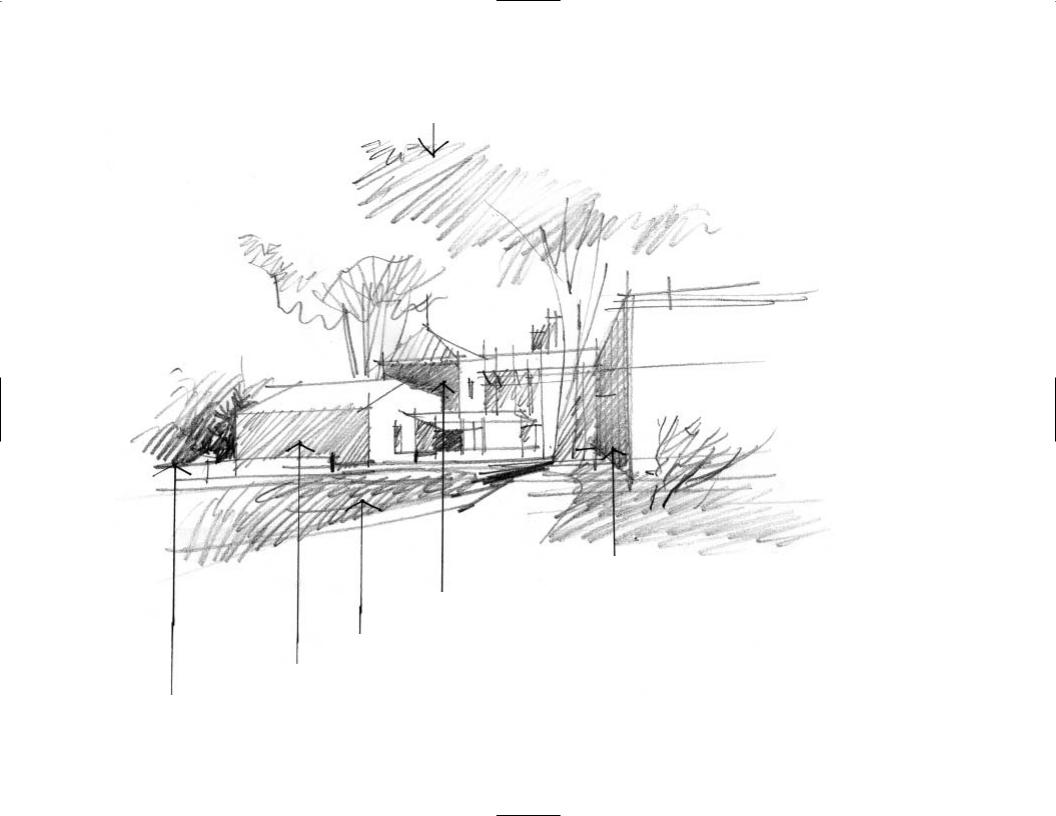
- •CONTENTS
- •PREFACE
- •Pencils
- •Papers
- •Accessories
- •Holding the Pencil
- •Pressure
- •Movement of the Hand
- •Lines and Strokes
- •Introduction
- •Observation and Recording
- •Landscape Sketching
- •Trees
- •Trees in the Foreground
- •Trees in the Background
- •Landforms
- •Water
- •Architecture
- •Sketching the Cityscape
- •SKETCHING FROM MEMORY
- •EXAMPLES
- •INDEX

Simple line
Short strokes
Long strokes
Continuing strokes
Lines and Strokes
Line refers to a long and continuous thread with a consistent width, while strokes are comparatively short and broken lines in a variety of widths. Line is the residual mark left on the paper as a result of a pencil gliding across it. It is graceful and fluid in nature. Strokes, on the other hand, are strike marks and they are often bold and deliberate.
In sketching, line is used to define spatial edges and describe objects. A variety of widths can be achieved by simply adjusting the angle of the lead. In theory, a hard lead produces a thin and light line, while a soft lead produces a dark and thick line. However, a good quality, soft sketching pencil is equally capable of producing a wide range of lines by itself. It is quite unnecessary to stock yourself with an array of leads because one or two simple pencils will do all the tricks.
In sketching, it is always a good idea to try to use a variety of line widths to avoid a monotonous look. For example, a profile line (a thicker line width) is used to visually lift the object from the background and to make the object look more three-dimensional. Different line widths within a sketch give the sketch a better sense of depth and space. This is especially evident when sketching landscape.
31

BASIC TEXTURES
Short individual strokes; change direction occasionally to create a cross-hatching effect.
A
Short, continuous strokes; change direction occasionally.
B
Continuous M-strokes; change direction constantly.
C
Continuous W-strokes; change direction constantly.
D
Very short M-strokes with constant direction.
E
32

PRACTICE STROKES (A)
PRACTICE STROKES (B)
PRACTICE STROKES (C)
Rotate pencil to get a sharp point
Begin with small finger movement; increase pressure on pencil; expand movement to include moving of the hand; use the wrist.
2/HB pencil
Focus primarily on finger movement; adjust angle of hand accordingly.
2/HB pencil
Short up/down strokes using finger movement; glide the hand across the page to repeat stroke; rotate pencil.
314 pencil
33

Bandstand in Zanzibar, Tanzania; H pencil
34

TEXTURES AND PURPOSES
Use texture to separate planes and explain the three-dimensional quality of the object.
Use texture to explain the sun/shade relationship.
Use texture to help describe the shapes.
35

CREATIVE USE OF TEXTURES
Texture and foliage
Describe receding planes
Create contrast
Describe ground
Separate wall from roof
Use contrast to push building forward
36
